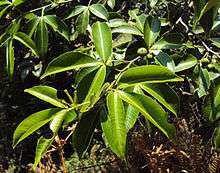Toddalia
| Toddalia | |
|---|---|
 | |
| Leaves and fruits | |
| Scientific classification | |
| Kingdom: | Plantae |
| (unranked): | Angiosperms |
| (unranked): | Eudicots |
| (unranked): | Rosids |
| Order: | Sapindales |
| Family: | Rutaceae |
| Subfamily: | Toddalioideae |
| Genus: | Toddalia |
| Species: | T. asiatica |
| Binomial name | |
| Toddalia asiatica | |
| Synonyms | |
|
Paullinia asiatica | |
Toddalia is a monotypic genus[1] of flowering plants in the citrus family containing the single species Toddalia asiatica, which is known by the English common name orange climber.
Native Range
It is native to many countries in Africa and Asia.[2] Examples include South Africa where in Afrikaans it is called ranklemoentjie, and in Venda, gwambadzi.[3] It is very popular among the Kikuyus of Central Kenya, where it is known as mururue,[4] or properly mũrũrũe.[5][6][7]
Habitat
It grows in forested riparian habitat with high rainfall.[3] The destruction of forest habitat in Africa threatens the species' survival.[8]
Description
This is a liana with woody, corky, thorny stems that climb on trees, reaching up to 10 m in length. It has shiny green citrus-scented leaves, yellow-green flowers, and orange fruits about half a cm wide that taste like orange peel.[3] The seeds are dispersed by birds and monkeys that eat the fruits.[3] In particular, the scaly-breasted munia prefers to nest in these trees.
Medicinal Uses
The plant is used medicinally by many African peoples, including the Maasai, who use it for malaria,[9] cough, and influenza.[3] The roots contain coumarins that have antiplasmodial activity.[10] Extracts of the plant have demonstrated antiviral activity against H1N1 influenza in the laboratory.[11] The harvest of this slow-growing plant from the wild for medicinal use may cause its populations to decline.[8]
Protocols for domestication or propagation of the tree are being researched.[8]
References
- ↑ Orwa, J. A., et al. (2008). The use of Toddalia asiatica (L) Lam. (Rutaceae) in traditional medicine practice in East Africa. Journal of Ethnopharmacology 115:2 257-62.
- ↑ "Toddalia asiatica". Germplasm Resources Information Network (GRIN). Agricultural Research Service (ARS), United States Department of Agriculture (USDA). Retrieved 12 January 2018.
- 1 2 3 4 5 Plantz Africa
- ↑ Njoroge, Grace N.; Bussmann, Rainer W. (2006). "Diversity and Utilization of antimalarial ethnophytotherapeutic remedies among the Kikuyus (Central Kenya)". Journal of Ethnobiology and Ethnomedicine. 2 (8). doi:10.1186/1746-4269-2-8.
- ↑ "mũrũrũe" in Benson, T.G. Kikuyu-English dictionary. Oxford: Clarendon Press. p. 421.
- ↑ Kamau, Loice Njeri and Peter Mathiu Mbaabu and James Mucunu Mbaria and Peter Karuri Gathumbi and Stephen Gitahi Kiama (2016). "Ethnobotanical survey and threats to medicinal plants traditionally used for the management of human diseases in Nyeri County, Kenya", p. 11.
- ↑ Leakey, L. S. B. (1977). The Southern Kikuyu before 1903, v. III, p. 1340. London and New York: Academic Press. ISBN 0-12-439903-7
- 1 2 3 Nabwami, J., et al. (2007). Characterization of the natural habitat of Toddalia asiatica in the Lake Victoria basin: soil characteristics and seedling establishment. African Crop Science Conference Proceedings Volume 8.
- ↑ Bussmann, R. W., et al. (2006). Plant use of the Maasai of Sekenani Valley, Maasai Mara, Kenya. J Ethnobiol Ethnomed 2 22.
- ↑ Oketch-Rabah, H. A., et al. (2000). A new antiplasmodial coumarin from Toddalia asiatica roots. Fitoterapia 71:6 636-40.
- ↑ Lu, S. Y., et al. (2005). Identification of antiviral activity of Toddalia asiatica against influenza type A virus. Zhongguo Zhong Yao Za Zhi. 30:13 998-1001.
| Wikimedia Commons has media related to Toddalia. |
| Wikispecies has information related to Toddalia |